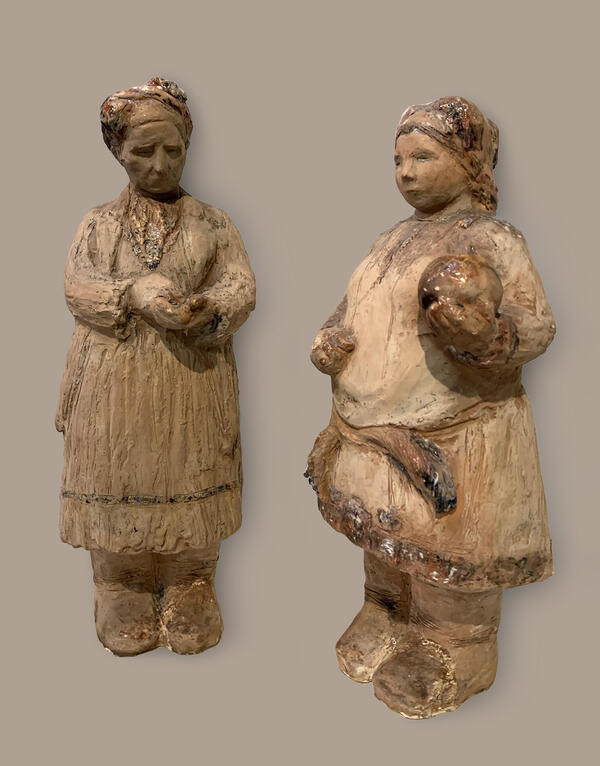Elena Rodionova, Honored Artist of the Mordovian ASSR, created both indoor and decorative sculpture. Her gift revealed itself most vividly in the small figures, and her favorite character was the rural hard-working woman. Professional observation helped the sculptor to feel the quiet and dignified character of Mordovian women, to emphasize their monumental grandeur. These features are well conveyed in the works “At the Fair”, “Spring”, “Mordovian Girl”.
“Mordovian Girl” is a round sculpture in the genre of female portrait. The woman’s image is visually complete; its three-dimensional shape is emphasized by the expressive play of perspectives. The young and supple face is drawn with precise and melodious lines. The rhythmic details (parts of the face, elements of the headdress) give the static composition a barely perceptible, graceful mobility.
The young girl is tender, full of sentiment and energy. Her restrained emotional impulse is palpable, and there is a shy fragility and insecurity in her open face. A light touch of reverie and sadness does not mask her delving into the innermost girlhood dreams. The voice of a woman’s hope for a happy life resounds with poignant force in the work. Her youthful beauty, sincerity and heartfelt sympathy create a lyrical, excited and feminine portrait. Spirituality and inner strength of the character speak of her integral nature and harmony.
The sculptor pays great attention to the girl’s headdress. It is conventional and generalized, the kind worn by young women in the first half of the 20th century. It resembles a panga — Moksha female headdress of a young married woman. However, the authentic national headdress was not blue, but terracotta and green. On the forehead there is a beaded string, and the side thread tassels in the form of cones are placed in two tiers.
Elena Rodionova’s ceramic sculptures are notable for their decorative and color effects, creating an iridescent glow to the surface. The subtle tonal shifts are obtained by double firing. The austere color of the ceramics suggests the abundant coloristic nature of the Mordovian peasant costume.
“Mordovian Girl” is a round sculpture in the genre of female portrait. The woman’s image is visually complete; its three-dimensional shape is emphasized by the expressive play of perspectives. The young and supple face is drawn with precise and melodious lines. The rhythmic details (parts of the face, elements of the headdress) give the static composition a barely perceptible, graceful mobility.
The young girl is tender, full of sentiment and energy. Her restrained emotional impulse is palpable, and there is a shy fragility and insecurity in her open face. A light touch of reverie and sadness does not mask her delving into the innermost girlhood dreams. The voice of a woman’s hope for a happy life resounds with poignant force in the work. Her youthful beauty, sincerity and heartfelt sympathy create a lyrical, excited and feminine portrait. Spirituality and inner strength of the character speak of her integral nature and harmony.
The sculptor pays great attention to the girl’s headdress. It is conventional and generalized, the kind worn by young women in the first half of the 20th century. It resembles a panga — Moksha female headdress of a young married woman. However, the authentic national headdress was not blue, but terracotta and green. On the forehead there is a beaded string, and the side thread tassels in the form of cones are placed in two tiers.
Elena Rodionova’s ceramic sculptures are notable for their decorative and color effects, creating an iridescent glow to the surface. The subtle tonal shifts are obtained by double firing. The austere color of the ceramics suggests the abundant coloristic nature of the Mordovian peasant costume.





